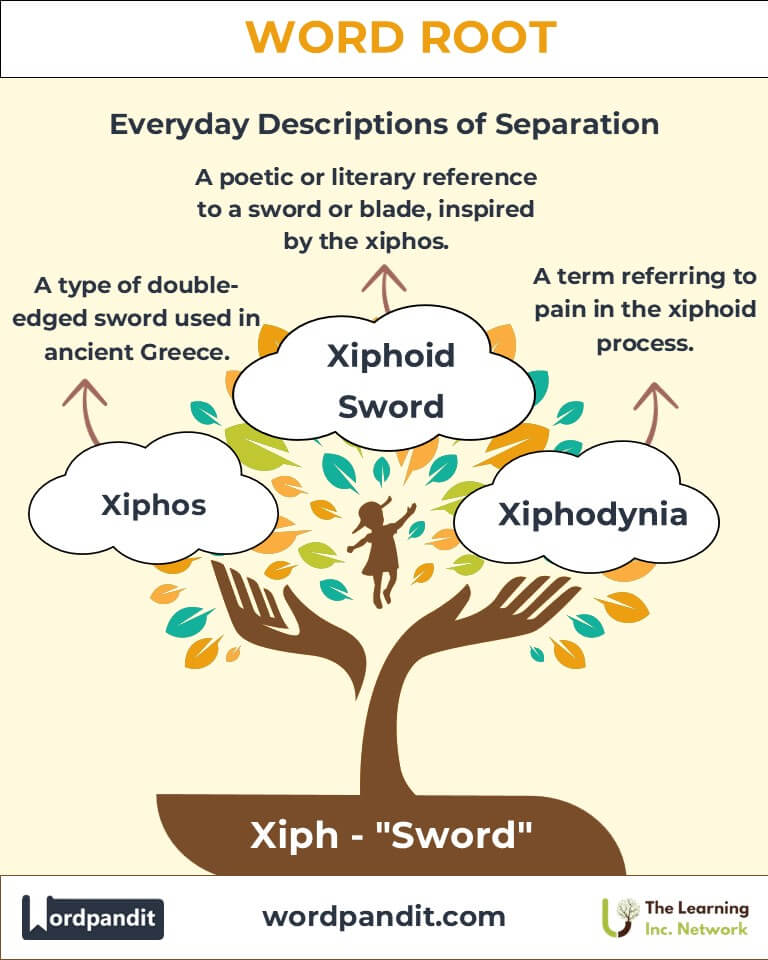Xiph: The Root of Swords in Language and Science
Byline:
Explore the sharp and fascinating legacy of the root "xiph", derived from the Greek word for "sword." From anatomical references like "xiphoid" to the ancient creatures named "xiphosura," this root cuts through language and disciplines with precision and depth.

Table of Contents
- Introduction: The Sharpness of Xiph
- Etymology and Historical Journey
- Mnemonic: Unlocking the Power of Xiph
- Common Xiph-Related Terms
- Xiph Through Time
- Xiph in Specialized Fields
- Illustrative Story: Xiph in Action
- Cultural Significance of Xiph
- The Xiph Family Tree
- FAQs about the Xiph Word Root
- Test Your Knowledge: Xiph Word Root Quiz
- Conclusion: The Cutting Legacy of Xiph
1. Introduction: The Sharpness of Xiph
What connects the delicate structure at the base of the sternum to an ancient group of armored sea creatures? The answer lies in the root "xiph" (pronounced "ziff"), meaning "sword." Derived from Greek, this root has sliced its way into anatomy, zoology, and even literature. "Xiph" evokes precision and elegance, capturing the essence of sword-like shapes and sharp concepts in language and science.

2. Etymology and Historical Journey
The root "xiph" originates from the Greek word xiphos (sword), symbolizing both function and form. In ancient Greece, the xiphos was a short, double-edged sword used by warriors in close combat, known for its practicality and deadly precision. Over time, this root transitioned into various fields of study, describing anything reminiscent of a sword’s shape or sharpness, from bones to marine creatures.
3. Mnemonic: Unlocking the Power of Xiph
To remember "xiph," imagine a shining sword, its blade tapering to a fine point. Now picture anatomical structures or creatures with similar shapes, embodying the elegance and functionality of a sword.
Mnemonic Device: "Xiph sharpens our understanding of sword-like forms in life and language."
4. Common Xiph-Related Terms
- Xiphoid (ziff-oid):
- Definition: Resembling a sword; specifically, the xiphoid process is the small, sword-like cartilage at the lower end of the sternum.
- Example: "The doctor pointed out the xiphoid process during the anatomy lecture."
- Xiphosura (ziff-oh-soo-rah):
- Definition: A group of ancient marine arthropods, including horseshoe crabs, whose tails resemble sword blades.
- Example: "Xiphosura are often referred to as living fossils due to their ancient lineage."
5. Xiph Through Time
- Xiphoid (17th Century): Originally used in anatomical studies, the term emphasized the sword-like appearance of this cartilage.
- Xiphosura (19th Century): Named for their sword-like tails, these creatures have been studied for their evolutionary significance and unique blood chemistry.
6. Xiph in Specialized Fields
- Anatomy:
- Xiphoid Process: This small structure plays a vital role in connecting the ribcage and providing attachment for muscles.
- Zoology:
- Xiphosura: These ancient creatures are crucial for studying arthropod evolution and are also valuable in biomedical research.
- Paleontology:
- Fossil Xiphosurans: Fossil records of these creatures help unravel the history of marine ecosystems.
7. Illustrative Story: Xiph in Action
During a biology field trip, young researcher Maya stumbled upon a preserved horseshoe crab on the shore. Its tail, sword-like and striking, reminded her of the "xiphosura" she'd read about. Intrigued, she conducted further research into its unique blood, eventually publishing a paper on its biomedical applications. Through this discovery, Maya realized how the sharp elegance of "xiph" shaped her understanding of life forms both ancient and modern.
8. Cultural Significance of Xiph
The xiphos sword was not only a tool of war but also a symbol of honor and skill in Greek culture. Its linguistic legacy lives on in the precise, sword-like structures and creatures described by the root "xiph." This root bridges ancient craftsmanship with modern scientific exploration, showcasing humanity's enduring fascination with sharpness and form.

9. The Xiph Family Tree
- Acro (Greek, "point" or "top"):
- Examples: Acrophobia – Fear of heights; Acropolis – A city at the top of a hill.
- Gladi (Latin, "sword"):
- Examples: Gladiator – A swordsman in ancient Rome; Gladius – A Roman short sword.
- Lam (Greek, "blade"):
- Examples: Lamina – A thin layer or plate; Laminated – Composed of thin layers.
10. FAQs About " Xiph "
Q: What does the root "xiph" mean, and where does it come from?
A: The root "xiph" means "sword" and originates from the Greek word xiphos. In ancient Greece, the xiphos was a short, double-edged sword used in battle. This root has been carried into modern language to describe anything with a sword-like shape or function, such as anatomical structures or certain marine creatures.
Q: What is the xiphoid process, and why is it important?
A: The xiphoid process is a small, sword-shaped cartilage located at the lower end of the sternum (breastbone). It serves as an attachment point for various muscles, including the diaphragm and the abdominal muscles. Though small, it plays a crucial role in the mechanics of breathing and core body movements.
Q: What are xiphosura, and why are they considered living fossils?
A: Xiphosura is a group of ancient marine arthropods that includes horseshoe crabs. They are called "living fossils" because their basic body structure has remained virtually unchanged for hundreds of millions of years. They also play a significant role in biomedical research due to their unique blue blood, which contains properties critical for detecting bacterial contamination in medical products.
Q: How is the root "xiph" used in zoology?
A: In zoology, "xiph" is used to describe structures or creatures with sword-like features. For example, the tail of xiphosura (such as horseshoe crabs) resembles the blade of a sword, which is why this group was named using the root "xiph."
Q: What is the connection between the root "xiph" and ancient Greek culture?
A: The connection lies in the xiphos, the sword used by Greek warriors. It was a vital weapon in close combat, symbolizing strength and precision. This association has influenced the use of the root in describing sharp, sword-like forms in language and science.
11. Test Your Knowledge: " Xiph " Mastery Quiz
1. What does the root "xiph" signify?
2. What is the xiphoid process?
3. Xiphosura are best known for their:
4. Which scientific field studies xiphosura fossils?
5. Why was the term "xiph" applied to the root of certain terms?
12. Conclusion: The Cutting Legacy of Xiph
The root "xiph" elegantly connects the precision of ancient swords to modern scientific and linguistic applications. Whether in anatomy or zoology, it carves out a unique niche in our understanding of the world. As we continue to explore its sharp connotations, "xiph" reminds us of the power of language to illuminate both history and science.












